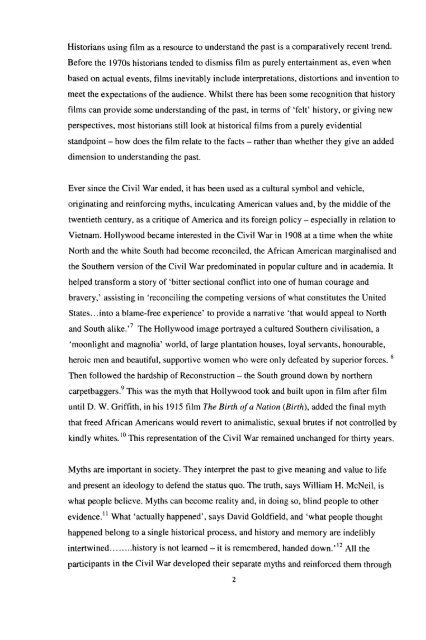Download (3483kB) - Greenwich Academic Literature Archive ...
Download (3483kB) - Greenwich Academic Literature Archive ...
Download (3483kB) - Greenwich Academic Literature Archive ...
- No tags were found...
Create successful ePaper yourself
Turn your PDF publications into a flip-book with our unique Google optimized e-Paper software.
Historians using film as a resource to understand the past is a comparatively recent trend.Before the 1970s historians tended to dismiss film as purely entertainment as, even whenbased on actual events, films inevitably include interpretations, distortions and invention tomeet the expectations of the audience. Whilst there has been some recognition that historyfilms can provide some understanding of the past, in terms of 'felt' history, or giving newperspectives, most historians still look at historical films from a purely evidentialstandpoint - how does the film relate to the facts - rather than whether they give an addeddimension to understanding the past.Ever since the Civil War ended, it has been used as a cultural symbol and vehicle,originating and reinforcing myths, inculcating American values and, by the middle of thetwentieth century, as a critique of America and its foreign policy - especially in relation toVietnam. Hollywood became interested in the Civil War in 1908 at a time when the whiteNorth and the white South had become reconciled, the African American marginalised andthe Southern version of the Civil War predominated in popular culture and in academia. Ithelped transform a story of 'bitter sectional conflict into one of human courage andbravery,' assisting in 'reconciling the competing versions of what constitutes the UnitedStates...into a blame-free experience' to provide a narrative 'that would appeal to Northand South alike.' 7 The Hollywood image portrayed a cultured Southern civilisation, a'moonlight and magnolia' world, of large plantation houses, loyal servants, honourable,heroic men and beautiful, supportive women who were only defeated by superior forces. 8Then followed the hardship of Reconstruction - the South ground down by northerncarpetbaggers. 9 This was the myth that Hollywood took and built upon in film after filmuntil D. W. Griffith, in his 1915 film The Birth of a Nation (Birth), added the final myththat freed African Americans would revert to animalistic, sexual brutes if not controlled bykindly whites. 10 This representation of the Civil War remained unchanged for thirty years.Myths are important in society. They interpret the past to give meaning and value to lifeand present an ideology to defend the status quo. The truth, says William H. McNeil, iswhat people believe. Myths can become reality and, in doing so, blind people to otherevidence. 11 What 'actually happened', says David Goldfield, and 'what people thoughthappened belong to a single historical process, and history and memory are indeliblyintertwined........history is not learned - it is remembered, handed down.' 12 All theparticipants in the Civil War developed their separate myths and reinforced them through2
















